
PREV ARTICLE
NEXT ARTICLE
FULL ISSUE
PREV FULL ISSUE
HIGHLIGHTS OF HERITAGE AUGUST 2018 PLATINUM SALEHere are some of the highlights of the upcoming Heritage August 17, 2018 Platinum Night Auction. Great coins! -Editor
Croesus Light Stater 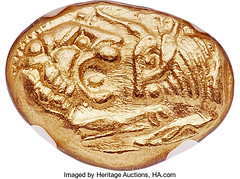
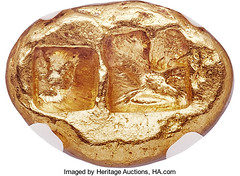
LYDIAN KINGDOM. Croesus and later (ca. 561-546 BC). AV stater (17mm, 8.08 gm). NGC Gem MS 5/5 - 5/5. Sardes, "Light" standard, ca. 553-539 BC. Confronted foreparts of lion (on left, facing right), with extended right foreleg, and bull (on right, facing left) / Two incuse square punches of unequal size. Carradice 8. BMFA 2073. SNG von Aulock 2875. Tied for the finest graded example, with blazing luster and eye appeal, and very rare as such. The conventional wisdom has always been that the light staters of Croesus were much more common than his heavy staters by a factor of three or four. However, in recent years, studies of auction appearances of both types have strongly suggested otherwise. Though the light stater was almost certainly produced for a longer period than the heavy stater, the survival rate for the former may be significantly less than previously thought. As such, new information and studies about the surviving population of each type lead to the conclusion that the light stater is actually the rarer of the two types. The market seems to already be catching on to this point, as another NGC Gem MS light stater sold in April of this year through a Japanese auction company for approximately $180,000.
To read the complete lot description, see:
Syracusan Euainetos Signed Decadrachm 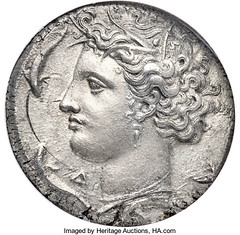
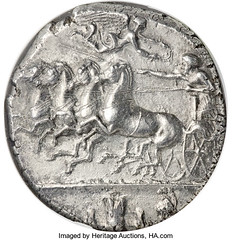
SICILY. Syracuse. Time of Dionysius I (ca. 405-370 BC). AR decadrachm (33mm, 43.11 gm, 8h). NGC Choice AU 5/5 - 4/5, Fine Style. Struck ca. 405-400 BC. Signed by the artist Euainetos. Charioteer, in flowing chiton, kentron in right hand, reins in left, driving racing quadriga left; Nike flying right above, about to crown charioteer with wreath; panoply of arms: cuirass between two greaves, with Phrygian helmet left on right in exergue on two slightly raised lines, all within a border of dots / S?-?-?-?-?S?O?, head of Arethusa left, wearing wreath of reeds, triple-pendant earring and necklace; ? below chin, four dolphins swimming around, signature ??-???? below the dolphin swimming under Arethusa's neck. Dewing 902 (same dies). Gallatin R.XI/D.I. Pozzi 614 (same dies). Rizzo pl. LIV, 6 and LVI, 5. Well centered and struck from dies of exceptional style. Attractive steel gray toning perfectly complements the masterful engraving of this glorious work of Greek art. One of the largest silver denominations minted in classical antiquity, the decadrachm of Syracuse remains one of the most alluring and celebrated coins in history. The immense size of this 10 drachm denomination offered the engravers of Syracuse the scope to fully display their mastery of the medium. After a brief "trial run" in the 460s BC, the decadrachm was reintroduced in Syracuse by the tyrant Dionysius following his assumption to power in 405 BC, testament to his grandiose vision to make Syracuse the foremost city in the Greek world. Two of the greatest local numismatic artists, Kimon and Euainetos, produced dies for the new series, each bringing their own distinctive style to the already iconic emblems of Syracuse: A racing four-horse chariot (quadriga) backed with a head of the beautiful Arethusa, nymph of the spring of Ortygia, surrounded by frolicking dolphins. Both engravers took great pride in their designs and signed their dies, much in the manner of a modern artist.
What's not to like about nymphs and frolicking dolphins? -Editor
To read the complete lot description, see:
'Star' Delphi Stater 
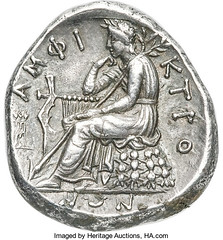
PHOCIS. Delphi. Ca. 338-334 BC. AR stater (24mm, 12.29 gm, 6h). NGC (photo-certificate) AU ? 5/5 - 5/5, Fine Style. Amphictionic issue. Veiled head of Demeter to left, wearing wreath of grain leaves / ??F?-????-?O?, Apollo seated left on omphalus, resting his chin on his right hand with his right elbow propped on a large lyre at his side, transverse laurel branch in left hand; small tripod in left field. Kinns, Amphictionic, 9. Kunstwerke der Antike: Sammlung Robert Käpelli (1963) 82 (this coin). Wayte Raymond, The Pierpont Morgan Collection: Catalogue of Greek and Roman Coins (1953) 177 (this coin). Splendid deep cabinet toning and excellent pedigree. The Temple of Apollo was destroyed by an earthquake in 373 BC and almost immediately the members of the Amphictionic League began collecting contributions to rebuild it. It was finally finished circa 330 BC and silver donations were struck into coins in the mid 330s BC as recorded in the fragmentary accounts of the Amphictions. In Kinns' reworking of Raven's original study of these coins, and of the treasury accounts that refer to them, he was able to provide us with a good idea about how many coins were actually struck, as well as their survival rate. Kinns was able to record 26 genuine staters, translating to mean that only one out of approximately ten thousand pieces originally struck still survives. The beautiful and delicate artisty of Demeter on the obverse is wonderfully complemented by Apollo with his lyre and sitting on the famous omphalus, which was thought to be in the adyton (sacred part of the temple) near the Oracle. The omphalus had a knotted net covering, a hollow center and widened toward the base and was believed to be the means to directly communicate with the gods, through the Oracle who would inhale vapors that would rise through the opening.
To read the complete lot description, see:
First Dollar of the Americas 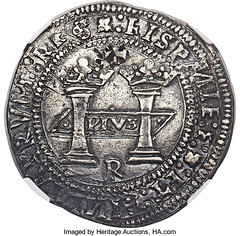
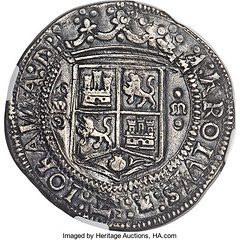
The Legendary First "Dollar" of the Americas - The Finest of Only 3 Known Specimens Charles and Johanna "Early Series" Rincón 8 Reales ND (c. 1538) •M•-•M• AU50 NGC, Mexico City mint, 36.5mm, 27.13g, KM-Unl., Calico-68, Nesmith-Unl. hISP[]?IE : [ornament?] : [ornament?] : ET : I?DIARRVM : RE [truncated S?]:, a pair of crown-topped pillars (representing the Pillars of Hercules), rhomboidal banner in between with the word PLVS, one pellet above, one in either corner; R below (for Francisco del Rincón), cross above (value marker), all with inner beaded border / AKROLVVS (V double struck) : [ornament?] : ET : IOhA?A : D, crowned shield with turrets in first and fourth quadrants (representing Castile), and lions in the second and third (representing Leon), pomegranate at bottom (representing Granada); •M• (mintmark, stacked) on either side, all within inner beaded border. Perfectly centered and well-struck for the type. Wonderful slate gray surfaces that continue to emit rays of gorgeous mint luster. Once considered to be a purely conjectural piece, this earliest of crown-sized coins struck in the New World--just two years after the establishment of the mint (later Mexico City) by royal charter in 1536--represents a minuscule group of just 3 known pieces recovered from the shipwreck of the "Golden Fleece" (sunk c. 1550) in 1990, and sold at public auction in 2004, 2006, and 2014 respectively. First suggested by the testimony of Francisco Tello de Sandoval after an investigation of the mint in 1545 (though legislation for the minting of such pieces had been issued on November 18, 1537), the present offering displays all of the tell-tale signs concordant with this and other 16th-century accounts while hardly evincing a trace of saltwater damage:
Wow! -Editor
To read the complete lot description, see:
Riga Double Ducat 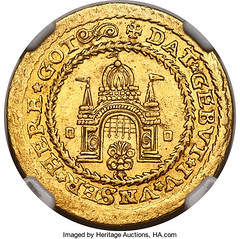
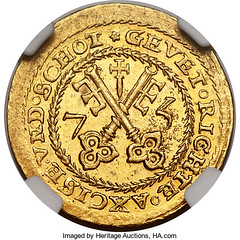
Riga. Free City gold 2 Ducat 1575-Dated MS62 NGC, 6.91g, 24mm, Gum-Unl., Kop-Unl., Hutten-Unl., cf. Reichel II, 409. + DAT ? GEBVT ? IV ? VNSER ? HERE ? GOT, city gate of Riga with small box(?) on either side within wreath / ? GEVET ° RICHTE ° AXCISE ° VND ° SCHOT, pair of crossed keys dividing date, dagger-like cross above, all within wreath. An extraordinarily rare, unpublished, and possibly unique piece. The obverse and reverse legends, which appear to be written in Old German and seem to the cataloger to be intended to be read continuously across both sides of the coin, may perhaps be interpreted as "This pray you, our Lord God, provide [us] safe passage and protection". This would correlate well with Riga's highly contested and war-ravaged status following the Hanseatic League's diminishing clout in the early decades of the 16th century, and its aspirations to maintain its independence, and serves as a proper caption to the visual image of the city gate with gate raised on the obverse.
To read the complete lot description, see:

Wayne Homren, Editor The Numismatic Bibliomania Society is a non-profit organization promoting numismatic literature. See our web site at coinbooks.org. To submit items for publication in The E-Sylum, write to the Editor at this address: whomren@gmail.com To subscribe go to: https://my.binhost.com/lists/listinfo/esylum All Rights Reserved. NBS Home Page Contact the NBS webmaster 
|